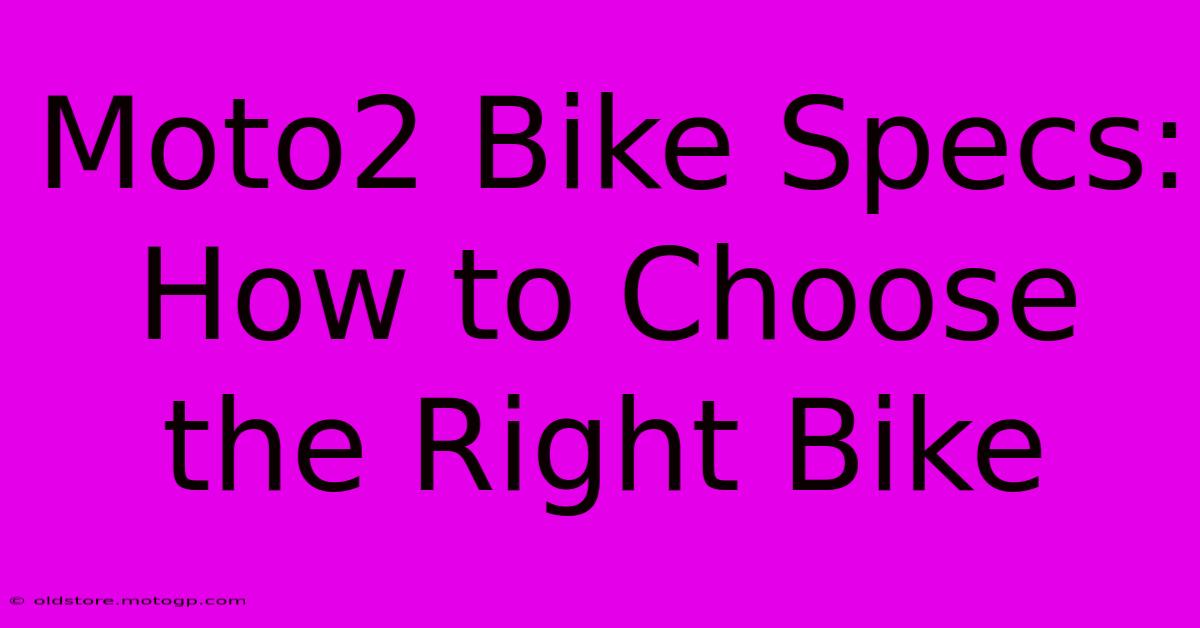Moto2 Bike Specs: How To Choose The Right Bike

Table of Contents
Moto2 Bike Specs: How to Choose the Right Bike
Choosing the right Moto2 bike is a crucial decision for any aspiring racer. These machines represent the pinnacle of middleweight racing technology, demanding a deep understanding of their specifications and a careful consideration of your individual needs and riding style. This guide delves into the key specifications to consider when selecting a Moto2 bike, helping you make an informed choice.
Understanding Moto2 Regulations and Standardization
Before diving into specific specs, it's essential to understand the inherent standardization within Moto2. Unlike MotoGP, Moto2 employs a single engine supplier, ensuring a level playing field. This means the focus shifts from engine development to chassis setup, rider skill, and tire strategy. The regulations dictate specific engine parameters, leaving teams to optimize the chassis, electronics, and aerodynamics to gain a competitive edge.
Key Considerations When Choosing a Moto2 Bike:
-
Chassis: The chassis is where you'll find the most significant room for customization and optimization within the Moto2 regulations. Different manufacturers offer varying chassis designs, each with its strengths and weaknesses in terms of handling, stability, and responsiveness. Consider factors like:
- Rigidity: A stiffer chassis provides better stability under braking and acceleration, but can be less forgiving on bumpy tracks. A more flexible chassis offers better comfort and adaptability to varying track conditions.
- Geometry: Head angle, trail, and wheelbase significantly impact handling characteristics. A steeper head angle generally leads to more agile handling, while a longer wheelbase offers greater stability at high speeds.
- Material: Most Moto2 chassis are constructed from aluminum, but some manufacturers may utilize carbon fiber components for weight reduction and improved stiffness.
-
Suspension: The suspension system plays a critical role in maximizing grip and rider comfort. Look for adjustable components that allow you to fine-tune the settings to match your riding style and track conditions. Key aspects include:
- Fork: Consider the type of fork (conventional, inverted), its travel, and its damping characteristics.
- Shock Absorber: The rear shock absorber's spring rate, damping, and ride height adjustments impact traction, stability, and overall handling.
-
Electronics: Although the engine is standardized, sophisticated electronics packages are used to optimize performance. These systems manage engine mapping, traction control, launch control, and wheelie control, allowing riders to fine-tune their machine’s response. Understanding these systems and their configurability is crucial for a competitive advantage.
-
Aerodynamics: Aerodynamics play a critical role in top-speed performance and stability, especially on long straights. Consider factors like fairing design, winglets, and overall aerodynamic efficiency. While regulations restrict extreme designs, small optimizations can make a big difference.
-
Tires: Tire selection significantly influences performance. Different tire compounds offer varying levels of grip in different conditions (dry, wet, warm, cold). Understanding tire characteristics and selecting the appropriate compound for a specific race is essential.
Choosing the Right Bike for Your Skill Level
While the Moto2 bikes themselves are highly sophisticated, the choice of a specific bike within the standardized regulations often depends on the rider's skill level and experience. A more experienced rider might prefer a chassis setup that offers greater responsiveness and feedback, allowing them to push the limits. A less experienced rider might favor a more forgiving and stable setup.
Factors to consider based on Skill Level:
- Beginner: Prioritize a bike with a stable and predictable chassis, forgiving suspension, and user-friendly electronics. Focus on consistency and building confidence before exploring extreme setups.
- Intermediate: Start to explore different chassis setups and suspension adjustments to find the sweet spot that suits your riding style. Begin experimenting with electronics to fine-tune performance.
- Advanced: Push the limits with more aggressive setups, experimenting with stiffer chassis, more responsive suspension, and fine-tuned electronics. Optimize the bike for specific tracks and conditions.
Ultimately, the best Moto2 bike for you depends on a combination of factors—your skill level, riding style, budget, and the specific goals you have for racing. Understanding these elements and thoroughly researching the specifications of different available options will enable you to make a well-informed decision. Don't hesitate to consult with experienced mechanics and racers to seek guidance on selecting the right machine for your needs.

Thank you for visiting our website wich cover about Moto2 Bike Specs: How To Choose The Right Bike. We hope the information provided has been useful to you. Feel free to contact us if you have any questions or need further assistance. See you next time and dont miss to bookmark.
Featured Posts
-
Grand Prix Red Bull The Ultimate Test Of Skill
Feb 25, 2025
-
F1 Austin The Perfect Blend Of Adrenaline And Melody
Feb 25, 2025
-
Qualifying Results Moto Gp Grid Set For A Thrilling Race Day
Feb 25, 2025
-
Cota Parking Pass The Perfect Race Day Companion
Feb 25, 2025
-
Cota F1 Maximize Your General Admission Experience
Feb 25, 2025
